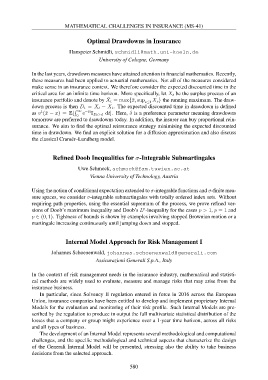Page 582 - 8th European Congress of Mathematics ∙ 20-26 June 2021 ∙ Portorož, Slovenia ∙ Book of Abstracts
P. 582
MATHEMATICAL CHALLENGES IN INSURANCE (MS-41)
Optimal Drawdowns in Insurance
Hanspeter Schmidli, schmidli@math.uni-koeln.de
University of Cologne, Germany
In the last years, drawdown measures have attained attention in financial mathematics. Recently,
these measures had been applied to actuarial mathematics. Not all of the measures considered
make sense in an insurance context. We therefore consider the expected discounted time in the
critical area for an infinite time horizon. More specifically, let Xt be the surplus process of an
insurance portfolio and denote by X¯t = max{x¯, sups≤t Xs} the running maximum. The draw-
down process is then Dt = X¯t − Xt. The expected discounted time in drawdown is defined
∞
as v1(x¯ − x) = E[ 0 e−δtIDt>d dt]. Here, δ is a preference parameter meaning drawdowns
tomorrow are preferred to drawdowns today. In addition, the insurer can buy proportional rein-
surance. We aim to find the optimal reinsurance strategy minimising the expected discounted
time in drawdown. We find an explicit solution for a diffusion approximation and also discuss
the classical Cramér–Lundberg model.
Refined Doob Inequalities for σ-Integrable Submartingales
Uwe Schmock, schmock@fam.tuwien.ac.at
Vienna University of Technology, Austria
Using the notion of conditional expectation extended to σ-integrable functions and σ-finite mea-
sure spaces, we consider σ-integrable submartingales with totally ordered index sets. Without
requiring path properties, using the essential supremum of the process, we prove refined ver-
sions of Doob’s maximum inequality and Doob’s Lp-inequality for the cases p > 1, p = 1 and
p ∈ (0, 1). Tightness of bounds is shown by examples involving stopped Brownian motion or a
martingale increasing continuously until jumping down and stopped.
Internal Model Approach for Risk Management I
Johannes Schoenenwald, johannes.schoenenwald@generali.com
Assicurazioni Generali S.p.A., Italy
In the context of risk management needs in the insurance industry, mathematical and statisti-
cal methods are widely used to evaluate, measure and manage risks that may arise from the
insurance business.
In particular, since Solvency II regulation entered in force in 2016 across the European
Union, insurance companies have been entitled to develop and implement proprietary Internal
Models for the evaluation and monitoring of their risk profile. Such Internal Models are pre-
scribed by the regulation to produce in output the full multivariate statistical distribution of the
losses that a company or group might experience over a 1-year time horizon, across all risks
and all types of business.
The development of an Internal Model represents several methodological and computational
challenges, and the specific methodological and technical aspects that characterize the design
of the Generali Internal Model will be presented, stressing also the ability to take business
decisions from the selected approach.
580
Optimal Drawdowns in Insurance
Hanspeter Schmidli, schmidli@math.uni-koeln.de
University of Cologne, Germany
In the last years, drawdown measures have attained attention in financial mathematics. Recently,
these measures had been applied to actuarial mathematics. Not all of the measures considered
make sense in an insurance context. We therefore consider the expected discounted time in the
critical area for an infinite time horizon. More specifically, let Xt be the surplus process of an
insurance portfolio and denote by X¯t = max{x¯, sups≤t Xs} the running maximum. The draw-
down process is then Dt = X¯t − Xt. The expected discounted time in drawdown is defined
∞
as v1(x¯ − x) = E[ 0 e−δtIDt>d dt]. Here, δ is a preference parameter meaning drawdowns
tomorrow are preferred to drawdowns today. In addition, the insurer can buy proportional rein-
surance. We aim to find the optimal reinsurance strategy minimising the expected discounted
time in drawdown. We find an explicit solution for a diffusion approximation and also discuss
the classical Cramér–Lundberg model.
Refined Doob Inequalities for σ-Integrable Submartingales
Uwe Schmock, schmock@fam.tuwien.ac.at
Vienna University of Technology, Austria
Using the notion of conditional expectation extended to σ-integrable functions and σ-finite mea-
sure spaces, we consider σ-integrable submartingales with totally ordered index sets. Without
requiring path properties, using the essential supremum of the process, we prove refined ver-
sions of Doob’s maximum inequality and Doob’s Lp-inequality for the cases p > 1, p = 1 and
p ∈ (0, 1). Tightness of bounds is shown by examples involving stopped Brownian motion or a
martingale increasing continuously until jumping down and stopped.
Internal Model Approach for Risk Management I
Johannes Schoenenwald, johannes.schoenenwald@generali.com
Assicurazioni Generali S.p.A., Italy
In the context of risk management needs in the insurance industry, mathematical and statisti-
cal methods are widely used to evaluate, measure and manage risks that may arise from the
insurance business.
In particular, since Solvency II regulation entered in force in 2016 across the European
Union, insurance companies have been entitled to develop and implement proprietary Internal
Models for the evaluation and monitoring of their risk profile. Such Internal Models are pre-
scribed by the regulation to produce in output the full multivariate statistical distribution of the
losses that a company or group might experience over a 1-year time horizon, across all risks
and all types of business.
The development of an Internal Model represents several methodological and computational
challenges, and the specific methodological and technical aspects that characterize the design
of the Generali Internal Model will be presented, stressing also the ability to take business
decisions from the selected approach.
580


